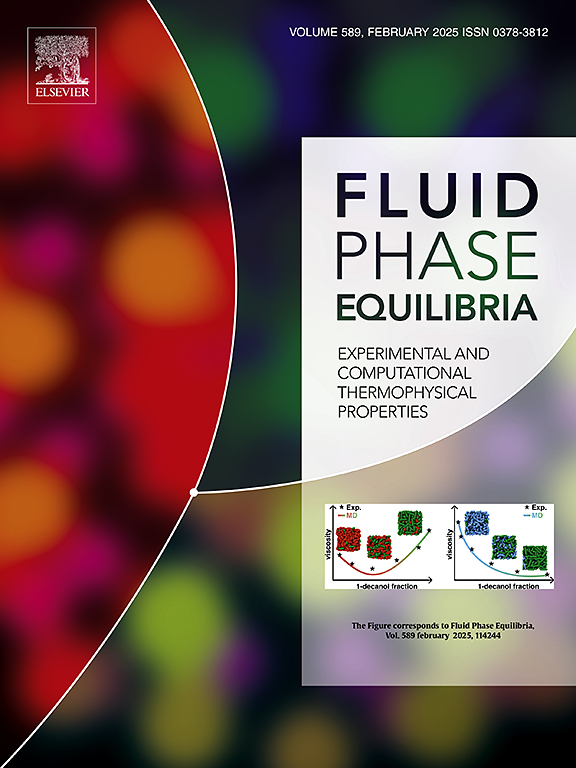Enhancing swelling kinetics of pNIPAM lyogels: The role of crosslinking, copolymerization, and solvent
IF 2.7
3区 工程技术
Q3 CHEMISTRY, PHYSICAL
引用次数: 0
Abstract
Stimuli-responsive lyogels are known for their ability to undergo significant macroscopic changes when exposed to external stimuli. While thermo-responsive gels, such as poly-N-isopropylacrylamide (pNIPAM), have been extensively studied across various applications, solvent-induced swelling has predominantly been investigated in aqueous solutions. This study explores the tailoring of lyogel formulations for future applications by controlling their solvent-induced swelling behavior, comparing both homopolymeric and semi-interpenetrating polymer networks (semi-IPNs). It is structured in two parts: the first focuses on characterization techniques, including NMR relaxometry, swelling degree measurements, mechanical testing, and SEM analysis, while the second part delves into swelling kinetic analysis, applying solvent exchange as a stimulus for varying gel formulations and solvents. In contrast to most previous studies, the impact of chemical and physical crosslinking, as well as copolymer inclusion, on the swelling behavior and mechanical properties of lyogels in organic solvents is examined and compared with solvent-induced swelling kinetics measurements. The results demonstrate that increasing chemically crosslinking in homopolymers and physically crosslinking in semi-IPNs enhances mechanical stability, while improving mass transport properties and solvent exchange kinetics. However, increases degree of crosslinking results in a prolonged response time to the solvent exchange stimulus and a reduction in the overall swelling capacity of the lyogels. Furthermore, variations in solvent properties, including molecular size and diffusion rates, significantly influence the swelling kinetics, whereas smaller, faster-diffusing solvents leading to more pronounced solvent spillage effects. Our findings highlight the complex interplay between gel formulation, network structure, and solvent nature in determining the solvent-induced swelling kinetics of lyogels, providing insights into how these materials can be tailored for specific applications especially those requiring short response times and optimized mechanical properties.

增强pNIPAM凝胶的溶胀动力学:交联、共聚和溶剂的作用
刺激反应性lyogels以其在暴露于外部刺激时经历显着宏观变化的能力而闻名。虽然热响应凝胶,如聚n -异丙基丙烯酰胺(pNIPAM),已经在各种应用中得到了广泛的研究,但溶剂诱导的溶胀主要是在水溶液中研究的。本研究通过控制溶剂诱导的溶胀行为,探讨了为未来应用而定制的lyogel配方,并比较了均聚和半互穿聚合物网络(semi- ipn)。它由两部分组成:第一部分侧重于表征技术,包括核磁共振弛豫测量,膨胀度测量,机械测试和SEM分析,而第二部分深入研究膨胀动力学分析,应用溶剂交换作为不同凝胶配方和溶剂的刺激。与之前的大多数研究相反,化学和物理交联以及共聚物包合对有机溶剂中lyogels的溶胀行为和力学性能的影响进行了研究,并与溶剂诱导溶胀动力学测量进行了比较。结果表明,增加均聚物的化学交联和半ipn的物理交联可以提高机械稳定性,同时改善质量传递性能和溶剂交换动力学。然而,交联程度的增加导致对溶剂交换刺激的反应时间延长,并降低了lyogels的整体膨胀能力。此外,溶剂性质的变化,包括分子大小和扩散速率,显著影响溶胀动力学,而更小、更快扩散的溶剂导致更明显的溶剂溢出效应。我们的研究结果强调了凝胶配方、网络结构和溶剂性质之间复杂的相互作用,这些相互作用决定了溶剂诱导的溶胀动力学,为这些材料如何适应特定的应用,特别是那些需要短响应时间和优化机械性能的应用提供了见解。
本文章由计算机程序翻译,如有差异,请以英文原文为准。
求助全文
约1分钟内获得全文
求助全文
来源期刊

Fluid Phase Equilibria
工程技术-工程:化工
CiteScore
5.30
自引率
15.40%
发文量
223
审稿时长
53 days
期刊介绍:
Fluid Phase Equilibria publishes high-quality papers dealing with experimental, theoretical, and applied research related to equilibrium and transport properties of fluids, solids, and interfaces. Subjects of interest include physical/phase and chemical equilibria; equilibrium and nonequilibrium thermophysical properties; fundamental thermodynamic relations; and stability. The systems central to the journal include pure substances and mixtures of organic and inorganic materials, including polymers, biochemicals, and surfactants with sufficient characterization of composition and purity for the results to be reproduced. Alloys are of interest only when thermodynamic studies are included, purely material studies will not be considered. In all cases, authors are expected to provide physical or chemical interpretations of the results.
Experimental research can include measurements under all conditions of temperature, pressure, and composition, including critical and supercritical. Measurements are to be associated with systems and conditions of fundamental or applied interest, and may not be only a collection of routine data, such as physical property or solubility measurements at limited pressures and temperatures close to ambient, or surfactant studies focussed strictly on micellisation or micelle structure. Papers reporting common data must be accompanied by new physical insights and/or contemporary or new theory or techniques.
 求助内容:
求助内容: 应助结果提醒方式:
应助结果提醒方式:


